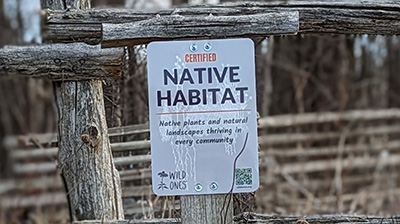Based on The Wild Ones Journal May/June 2002 issue, updated February 2020
These guidelines, meant to assist Wild Ones members and others in their natural landscaping efforts, were developed using scientific literature and after consulting with experts. This information is to help you choose native plants for gardens and landscapes that support biodiversity, ecological integrity, and ecosystem health.
“Native plant” defined – A native plant species is one that occurs naturally in a particular region, ecosystem and/or habitat, and was present prior to European settlement.
Selecting for the local genotype – Wild Ones advocates for selecting native plants and seeds originating, whenever possible, from local or regional sources having the same or similar environmental conditions as the planting site. Such plant material is often termed the “local genotype.”
“Environmental conditions” include soil characteristics, drainage, pH, sun/shade, prevailing wind direction, temperature range, precipitation, elevation, aspect (such as north/south slope).
In encouraging the use of local or regional sources for your native plant materials, we mean those defined by ecological, not political boundaries. When you can’t get suitable local native plants, select plants or seeds from your ecoregion in a nearby state, rather than plants from your state from a different ecoregion with dissimilar environmental conditions. U.S. ecoregions are well delineated by the U.S. EPA’s Ecoregions of North America, Level III map. (Also, see our paper titled “Ecoregions, Native Ranges, and Hardiness Zones Explained.”)
Key reasons to choose local genotypes
1. To preserve the genetic diversity and integrity of native plants.
Whether in landscaped or natural areas, an all-important concern is preserving not only a diversity of plant species, but also the genetic diversity within each species. Native species vary genetically in their adaptation to their environmental conditions and ecological relationships where they grow. This results in various genotypes for the same species over its range.
2. To help support other species.
Pollinators, other insects, birds, mammals, and other wildlife have co-evolved with local genotype plants and depend upon them for seasonally-available food and shelter in a well-functioning habitat.
3. To ensure the greatest success in your landscaping efforts.
Take your cues from nature. The more closely you match your environmental conditions with the plant species’ naturally-occurring habitat, the better your native plants will thrive. Complex interactions develop between species within habitats, so also consider growing a few more plants associated from the same habitat for optimal growth.

